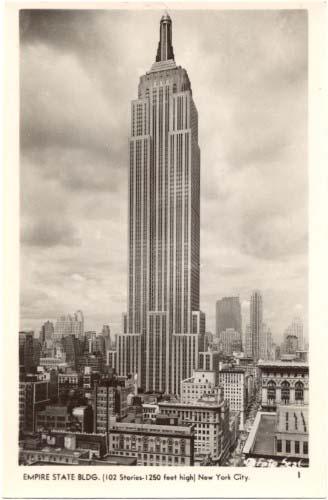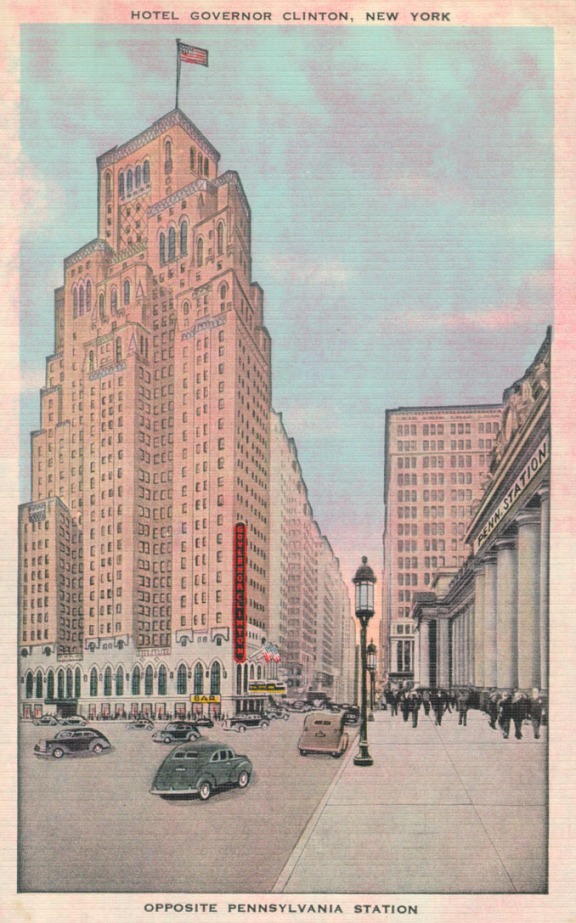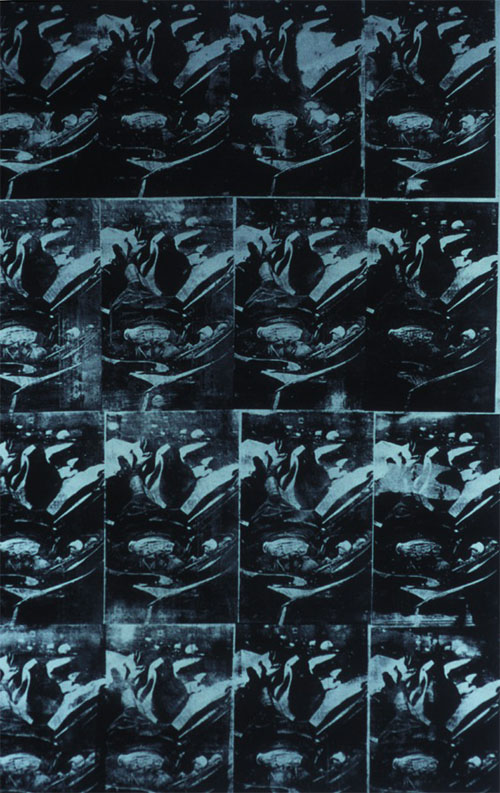When the Empire State Building officially opened in 1931, it was an engineering marvel: by far the tallest structure on the planet, and built in just 16 months during the depths of the Great Depression. Though the weak economy caused it to sit almost empty for many of its earlier years, the building’s lofty observation deck drew crowds in immense numbers. In fact, the building’s owners made roughly as much in observation deck ticket sales during its first operational year as it collected from office rentals in the tower itself.

Women on the Empire State Building’s 86th floor observation deck in the 1940s. Note the low guard rail.
The observation decks on the 86th and 103rd floors were an instant hit. Tourists and locals alike happily took rides in the building’s sleek high-speed elevators hundreds of feet above the street to absorb the breathtaking views, which on clear days, stretched all the way to Connecticut.
But the building also became rather quickly known for something far more tragic. One by one, people in their darkest moments ascended to its upper decks, climbed over the railing, and threw themselves to the ground far below. Many ended up landing on the roof of one of the building’s many setbacks on their way down. At least one woman was actually blown back onto the observation deck by a strong gust of wind, and survived. But some cleared the building completely and sailed all the way down to the pavement, more than 1,000 feet away.
Evelyn Francis McHale was born in Berkeley, California, on September 20, 1923, the 6th of 7 children born to Vincent and Helen McHale. In 1930, the family moved to Washington D.C. for Vincent’s job, but within a few years, Helen moved out of the house for unknown reasons. Vincent retained custody of their 7 children, and later moved with them to Tuckahoe, New York, where Evelyn attended high school.
After graduation, Evelyn joined the Women’s Army Corps, and was stationed in Jefferson, Missouri. It was reported by friends that when she left the Corps, she burned her uniform. She moved to Baldwin, New York, on Long Island, where she lived with her brother and his wife, and she got a job as a bookkeeper at the Kitab Engraving Company on Pearl Street in the Financial District of Manhattan.
During this time, Evelyn met a young former Airman by the name of Barry Rhodes, who was a student at Lafayette College in Easton, Pennsylvania, about 90 minutes west of New York. The two were soon engaged, but a shadow seemed to hang over Evelyn. In the Spring of 1946, she served as a bridesmaid in Barry’s brother’s wedding. After the ceremony, she ripped off her dress, declaring, “I never want to see this again,” and burned it like she had done with her A.W.C. uniform.
On April 30, 1947, Evelyn took the train from New York to Easton to visit Barry for his 24th birthday. All seemed well between the couple, and the next day, Barry kissed his fiance goodbye as she boarded the 7:00 AM train to Penn Station. “When I kissed her goodbye, she was happy and as normal as any girl about to be married.” Their wedding was set to be held at Barry’s brother’s home in Troy, New York, that June.
What was really running through Evelyn’s mind that morning, no one will likely ever know. Upon arriving in Manhattan, she left Penn Station and walked across the street to the Governor Clinton Hotel at 31st Street and 7th Avenue. She obtained a room, and set about writing a note. It read (strike-throughs included), “I don’t want anyone in or out of my family to see any part of me. Could you destroy my body by cremation? I beg of you and my family – don’t have any service for me or remembrance for me. My fiance asked me to marry him in June. I don’t think I would make a good wife for anybody. He is much better off without me. Tell my father, I have too many of my mother’s tendencies.”
She folded her note, and tucked it into her small purse along with a few dollars, her make-up, and some family photos. At 10:30 AM, she walked to the Empire State Building, and purchased a ticket to its famous 86th-floor observatory. She slipped off her coat and placed it along with her pocketbook on the floor against the railing. And she jumped.
That morning, Patrolman John Morrissey was directing traffic at 34th Street and 5th Avenue. At 10:40 AM, he noticed a white scarf fluttering down from the upper reaches of the tower. Just a moment later, the day’s serenity was interrupted by a terrific crash that sounded like an “explosion.” A crowd formed on 33rd Street beneath the building as pedestrians swarmed to see what had happened.
Lying on her back, clutching a strand of pearls at her neck, Evelyn looked to be resting peacefully. Were it not for the fact that she was nestled snugly into the crushed roof of a United Nations Assembly Cadillac, she could even be mistaken for being asleep. But the poor woman, just 23 years old, was dead. A young photography student by the name of Robert C. Wiles happened to be across the street at the time of her demise. Stunned by her beauty, even in death, he snapped a photo of her just 4 minutes after her crash. Almost overnight, she became a pop culture icon: a symbol of tragic beauty.
Evelyn’s sister, Helen , fulfilled the task of identifying her body. Per her wishes, she was cremated and there is no grave dedicated to her. But she lives on through that iconic photo of her final moment. First published in the May, 1947 issue of LIFE Magazine, it has been discussed and reproduced for decades. Even Andy Warhol produced a series of pieces inspired by Robert C. Wiles’ photo of Evelyn.
Evelyn was the 5th suicide or attempt from the Empire State Building within a 3-week period in 1947. In response to her death and its publicity, the building erected a much taller fence to deter would-be jumpers, and they now train security guards to recognize the signs of a potential suicide case attempting to climb the building. Despite everything, more than 30 people have ended their lives in this way since the tower’s construction, including one distraught construction worker.
It seems that Evelyn’s wish for there to be “no remembrance” of her is never to be fulfilled. The romance of her story and her morbid glamor live on in the imaginations of generations who, perhaps, see a little bit of themselves in this tragic bride-to-be.
A note to readers: I have received a number of E-mails questioning the originality of this blog post. I have tried to personally respond to each of my accusers, as I take the idea of “plagiarism” very seriously. I hold a Bachelor’s Degree in History, and I understand fully the need to give credit always where credit is due. That said, this blog is (was) a silly hobby of mine with a readership that barely reached beyond my mother and a few facebook friends. When I originally decided to write about Evelyn McHale in October 2012, I was deeply disappointed to find an almost complete lack of “new” information about her life anywhere on the internet. My main source, The New Yok Times archives, had but one article, dated May 2, 1947, which offered a few quotes, some vague details about her life, and little else. So, like any good 21st-century historian (whose daily readership at the time numbered in the dozens), I turned to Google, where I was disappointed again. Blog post after blog post telling essentially the same story. Evelyn McHale: sixth of seven children, rode the train into Penn Station, left a suicide note, jumped to her death, immortalized by a photograph. Frustrated, I took these loose details, jumbled them together using my own “voice,” and considered the post to be among my weakest. Somewhere along the line, however, the piece was picked up by first one, then several other websites. My blog now receives thousands of hits per day, almost all of which go directly to Evelyn’s story (and, disappointingly, seldom anywhere else on the page – we’re talking 99% of my traffic goes only to Evelyn). I can’t hope to understand why this particular post has taken off with such velocity, but I assure you all that it is perhaps the least-original and least-satisfying of the stories I’ve told through KeithYorkCity (no offense meant to Evelyn – but I like a story where I am able to dig up hitherto undiscovered historical details in my scholarly research). But short of trying to track down her surviving family, I couldn’t imagine a way to add anything “new” to the tale. Plagiarism, however, was never intended, and any similarities to other blogs are genuinely coincidental. The long-and-short of it: I collected what data I could from a variety of online sources, dug up whatever photographs were available to me through Google, cited those where I could , and pieced what I had together into an essay that I wouldn’t be proud to turn in to my High School English teacher, much less to any discerning historical audience as I hope I have attracted here. Please do visit the blog which I am accused of copying. Codex99 is a superior blog to mine in all ways and I tip my hat to its author. I welcome discourse on my blog and its topics, but do wish to put a cap on the plagiarism accusations. Please take time to peruse my blog’s numerous other articles of much greater depth and detail: Evelyn Nesbit, The Grand Central Hotel, Audrey Munson. I thank you all for reading!










I have been working on a narrative nonfiction story titled “Evelyn” for quite some time. This famous photo taken after a woman jumped off the Empire State Building in 1947 is what inspired me.
Nine months later, I have more information about this woman, Evelyn McHale, than anyone else to date. I have so much unknown information about her, and have done so much research and writing, that I have the support of not only some of the most prominent figures in ASU’s English department, but from some of the most successful authors in the literary world. In August, I will begin a writing internship to write, revise, prepare my manuscript for publication by this December.
I have started a crowdfunding campaign for two reasons – I need to hire a lawyer to copyright my work, as it has been plagiarized several times. I also need to complete my research by the end of this summer. Many of the things I need, I can only access from New York. These are the main two things I am crowdfunding for– but I have no idea how big this could get, which is why I set a high goal. You are able to donate as low as $5.
If you could please share this and support my novel, it would be very appreciated. I truly hope that my novel captivates readers as much as her photograph has, and I believe I will have a strong audience because of the mystery she had left behind. Also, there are rewards for each person who decides to support “Evelyn” and I!
http://www.evelyn.pubslush.com
Pingback: Forgotten Women Victims of the 1940s | Grin and Bare It - The Black Dahlia Murder Case
People who read blogs then jump all over them looking for plageurism are pitiful. No one has claimed to be entirely original. Myself, I always include a link back to the original blog or to Wikipedia or any other source I have used to write a blog. That IS acknowledgement of the original author/source. Seriously get a life.
First it was McHale who was an icon for tragic, young beauty. About 7 years later it was the Black Dahlia. There were hundreds of women in between, many of whom were murdered in as heinous a manner as Elizabeth Short. Who knows why certain people become an icon and certain people don’t? Maybe it’s the label the press gave her. So much for saying “what’s in a name?”
She’s my dads aunt. I guess that makes her my great aunt? Anyway, my old man says she was depressed. Such a beautiful young lady. A real shame. Eerily peaceful look on her face. No more pain. R.I.P. Evelyn.
Hi Mike, thanks for reading. My condolences go out to your family. Evelyn’s is indeed a very sad story.
-Keith
Excellent article, great blog. My first thought when I read this was to wonder if perhaps she had been sexually assaulted while in the WACS? Women often felt a great deal of shame, even when it was in no way their fault. Burning the uniform, the dress, saying she didn’t want anyone to see her body, the suicide shortly after meeting with her fiance…Fear of the upcoming marriage,…sex… If she had been traumatized, those things could all fit together. As for the reference to her mother, that could be taken many ways. If she felt shame for being assaulted, she could tie that in to any sexuality, including her mothers? Quite the mystery. So many questions.
Pingback: No one dies alone | Got Five Minutes?